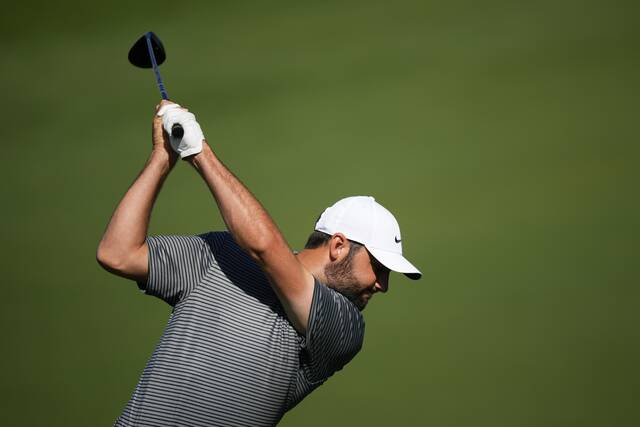AUGUSTA, Ga. — Golf post the prime years of Tiger Woods is similar to the time before his famous “Hello, world” introduction.
There was an abundance of talent and rivalries as well.
But there was no dominant figure.
Nick Faldo and Greg Norman globalized golf for about a decade until Woods appeared. Norman spent more time at No. 1 in the world. Faldo won three times as many majors (6-2). Fred Couples was the American hope. He had unmatched cool and charisma, but was hindered by a troublesome back.
Woods completely changed the game. His popularity and dominance boosted television ratings and prize money. Whether it was 142 consecutive cuts, a 15-shot victory in the U.S. Open, or holding all four majors simultaneously, it was unprecedented in golf.
“I don’t know if we’ll ever see anything like that again in the game of golf,” said Scottie Scheffler, the current top golfer.
Scheffler is close to being just the third player since Woods to hold the No. 1 ranking for more than a year, joining Rory McIlroy (2014-15) and Dustin Johnson (2017-18). This is a strong indicator of the balance at the top.
Scheffler is among the 10 players who have been No. 1 in the world since Woods was last there on May 11, 2014.
There was the potential for a rivalry with Jon Rahm until the Spaniard left for LIV Golf and Saudi money. However, LIV Golf can’t create rivalries because everyone is wealthy and content. Even Brooks Koepka and Bryson DeChambeau seem to like each other now.
What golf lacks — and what it might need — is a dominant player.
“I think it would be good for the game,” Scheffler said. “I think anytime you have a figure that kind of dominates … like I think of like the NBA. You look at Steph Curry for those years where the Warriors were winning a bunch, people would say they got tired of it. But at the end of the day, people were still showing up and watching because he was incredible to watch, and you want to watch greatness when you’re out there.”
Golf hasn’t seen that since Woods, and then it’s a matter of deciding exactly when he stopped ruling the sport, at least inside the ropes. From a sheer performance standpoint, his days of dominance ended when he ran into that fire hydrant around Thanksgiving 2009 and shocking tales of a sordid private life came gushing out.
Yes, he returned to No. 1 and held it for more than a year in 2013, when he won five times and was voted PGA Tour Player of the Year for the 11th time. But thanks to four back surgeries, it wasn’t until 2019 that he ended an 11-year drought in the majors.
Dominant play is different from appeal. Even now, with a body so broken that Woods has played only 24 holes in one tournament going into the Masters, it was big news that his plane was tracked flying to Augusta in April.
The top five players in golf combined don’t match his appeal. No need to look any further than the PGA Tour’s contrived “Player Impact Program” that doled out $15 million to Woods when he was hardly even playing.
No amateur has been like Bobby Jones. There hasn't been another major champion as successful as Jack Nicklaus. There hasn't been anyone as deserving of the title “The King” since Arnold Palmer. And, as Scheffler mentioned, it's unlikely that there will be another player like Woods.
It seems unlikely that a dominant player will emerge soon.
In his 10th year on the PGA Tour, Justin Thomas was asked to name golf’s most dominant player during his time on tour.
He cited Johnson and McIlroy, and confidently included himself in the list based on his 2017 season when he won five times, including his first major.
“I find myself doing this often with other sports,” Thomas said. “It's a recent bias. It's whatever happens most recently. That's the only thing on your mind.”
Jordan Spieth could have fit that description in 2015 when he won the Masters and U.S. Open, missed the British Open playoff by one putt, and was runner-up in the PGA Championship. Jason Day displayed no visible flaws in his game when he won seven times in 10 months, including the PGA Championship and The Players Championship.
They come and go.
Scheffler seems to have lasting power, evident from his performance tee-to-green, and his significant lead in the world ranking. But for how much longer?
Johnson seemed unbeatable in 2017 until he fell down a flight of stairs on the eve of the Masters. McIlroy won the last two majors of 2014 and was still climbing until he decided to play soccer with friends and tore ligaments in his ankle.
It might be wise for Scheffler to take it easy with pickleball.
“You have had a lot of guys that go through stretches,” Scheffler said. “You had Jordan go through his stretch. You had a year where JT won five times. You had those years where Rory was winning majors by a bunch of shots.
“Nobody’s really been able to have the longevity that Tiger had.”



